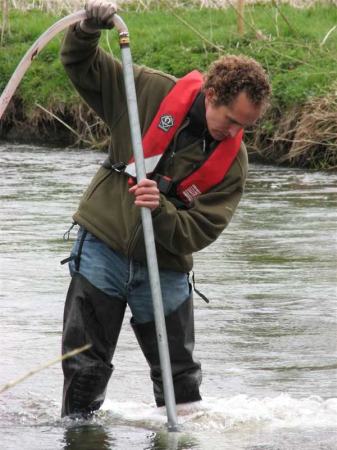Spawning fish in Norfolk’s River Wensum are being given a helping hand through a partnership between local anglers and staff from the Environment Agency’s Fisheries Recreation and Biodiversity and Ecological Appraisal teams.
Forming part of the Wensum Fisheries Action Plan and on-going research into the spawning success of the river’s barbel population, anglers have been asked to help identify known spawning sites in the river and monitor fish activity during the spawning season.
Steve Lane, Technical Specialist from the Environment Agency said, “Barbel and other coarse fish such as chub need shallow, fast-flowing stretches of clean gravel in which to lay their eggs. After hatching, the young fish live within the gravel beds or ‘riffles’ as they develop, then move out into open water to find other suitable habitats. If the gravel is choked with sand and silt then fish may not spawn successfully and few of the young fish will survive.â€
To help improve their chances, Environment Agency staff are using high-pressure water jets to flush out sand from the gravel beds to provide an ideal site for the fish to spawn. So far, sites at Lyng, Taverham and Costessey have been cleaned in this way.
Steve explained, “Later in the year, electro-fishing surveys will help us to monitor the number of young fish produced and keep a check on their growth and survival.â€
 Electro-fishing is an essential and effective technique for managing fisheries, either still waters or rivers. Usually done from a boat or by wading in shallow water, electric fishing uses the physiological effect of an electric field in water to stimulate a fish’s nervous system so that it swims towards the operator or is unable to swim away and can be caught. After the fish has been caught it can then be assessed for health, age, length, growth rate and sex before being returned to the river.
Electro-fishing is an essential and effective technique for managing fisheries, either still waters or rivers. Usually done from a boat or by wading in shallow water, electric fishing uses the physiological effect of an electric field in water to stimulate a fish’s nervous system so that it swims towards the operator or is unable to swim away and can be caught. After the fish has been caught it can then be assessed for health, age, length, growth rate and sex before being returned to the river.
In the longer term, initiatives such as Catchment Sensitive Farming will help to reduce the amount of silt and sand run-off entering the river. Pollution caused by agriculture can have serious effects on local rivers, lakes, estuaries and coastal waters. An over-loading of nutrients lost from fields can boost the growth of algae. Oxygen levels can then become depleted, effectively suffocating the fish. Catchment Sensitive Farming is an initiative aimed to promote water-friendly farming, helping to tackle agricultural pollution and thus improve conditions for wildlife.
The barbel is a stunning fish to behold. They’re usually golden bronze, fading to a creamy white on the belly. The fins are reddish brown, sometimes with an orange tinge. It’s not only an attractive combination of colours but also a highly effective one for camouflage purposes. The barbel gets its name from the two pairs of fleshy barbels. A barbel on a fish is a slender, whisker-like tactile organ near the fish’s mouth. Other fish that have barbels include catfish, carp, sturgeon and some species of shark. They house the taste buds of such fish and are used to search for food in murky water. Barbel are torpedo-shaped, long, muscular fish with large triangular pectoral fins that have the power to cope with periods of high flow and to take off at extremely fast bursts of speed.
They are a bottom-dwelling species, preferring cleaner rivers with stretches of gravel, riffles, pools and deeper glides. Sexual maturity usually occurs at four to five years old. Spawning takes place from May until the end of June, although given the right water temperature it sometimes carries on into July. Females congregate in shallower areas and are usually accompanied by more than one male. Their eggs and milt (male sperm) are shed simultaneously and depending on the size of the female, up to 30,000 eggs can be liberated at one time.
The eggs are fertilised and stick to nearby fronds of weed and gravel. During the process other fish species downstream of the spawning adult will try to devour any stray eggs. Temperature can affect the time it takes the eggs to hatch, but it’s usually 10 to 15 days. After hatching, the tiny fry drift off into quieter waters and spend a few days absorbing the yolk sac. At 7mm to 8mm long, they start to feed on small insect larvae and crustaceans, graduating to larger invertebrates such as snails and mussels and various insect larvae as they get bigger.
According to folklore, barbel used to be called pigfish. It’s an unflattering reference to the way they root and grub on the riverbed while foraging for food. Barbel could also be described as pigheaded, given the way the fiercely resist once they have been hooked. Such fighting helps explain why the species is so popular among anglers. Its resurgence in our rivers, following habitat improvement and targeted restocking programmes, is one of the biggest success stories of recent years.
If you haven’t yet sampled the unique beauty of the barbel and the thrilling sport it can provide, why not give it a try?









